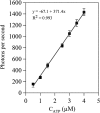Piezo1 regulates mechanotransductive release of ATP from human RBCs
- PMID: 26351678
- PMCID: PMC4586865
- DOI: 10.1073/pnas.1507309112
Piezo1 regulates mechanotransductive release of ATP from human RBCs
Abstract
Piezo proteins (Piezo1 and Piezo2) are recently identified mechanically activated cation channels in eukaryotic cells and associated with physiological responses to touch, pressure, and stretch. In particular, human RBCs express Piezo1 on their membranes, and mutations of Piezo1 have been linked to hereditary xerocytosis. To date, however, physiological functions of Piezo1 on normal RBCs remain poorly understood. Here, we show that Piezo1 regulates mechanotransductive release of ATP from human RBCs by controlling the shear-induced calcium (Ca(2+)) influx. We find that, in human RBCs treated with Piezo1 inhibitors or having mutant Piezo1 channels, the amounts of shear-induced ATP release and Ca(2+) influx decrease significantly. Remarkably, a critical extracellular Ca(2+) concentration is required to trigger significant ATP release, but membrane-associated ATP pools in RBCs also contribute to the release of ATP. Our results show how Piezo1 channels are likely to function in normal RBCs and suggest a previously unidentified mechanotransductive pathway in ATP release. Thus, we anticipate that the study will impact broadly on the research of red cells, cellular mechanosensing, and clinical studies related to red cell disorders and vascular disease.
Keywords: ATP release; Pizeo1; RBCs; calcium flux; mechanosensing.
Conflict of interest statement
The authors declare no conflict of interest.
Figures








References
-
- Ho J, Sibbald WJ, Chin-Yee IH. Effects of storage on efficacy of red cell transfusion: When is it not safe? Crit Care Med. 2003;31(12 Suppl):S687–S697. - PubMed
-
- Schmid-Schöenbein H, Wells R. Fluid drop-like transition of erythrocytes under shear. Science. 1969;165(3890):288–291. - PubMed
-
- Vague P, Juhan I. Red cell deformability, platelet aggregation, and insulin action. Diabetes. 1983;32(Suppl 2):88–91. - PubMed
-
- van der Heyde HC, Nolan J, Combes V, Gramaglia I, Grau GE. A unified hypothesis for the genesis of cerebral malaria: Sequestration, inflammation and hemostasis leading to microcirculatory dysfunction. Trends Parasitol. 2006;22(11):503–508. - PubMed
-
- Fischer DJ, Torrence NJ, Sprung RJ, Spence DM. Determination of erythrocyte deformability and its correlation to cellular ATP release using microbore tubing with diameters that approximate resistance vessels in vivo. Analyst (Lond) 2003;128(9):1163–1168. - PubMed
Publication types
MeSH terms
Substances
LinkOut - more resources
Full Text Sources
Other Literature Sources
Miscellaneous

